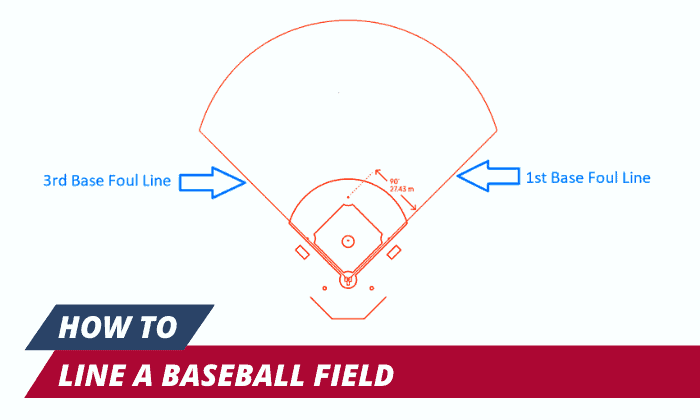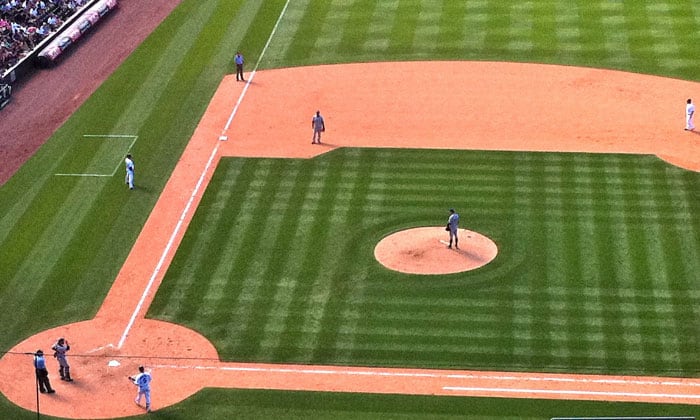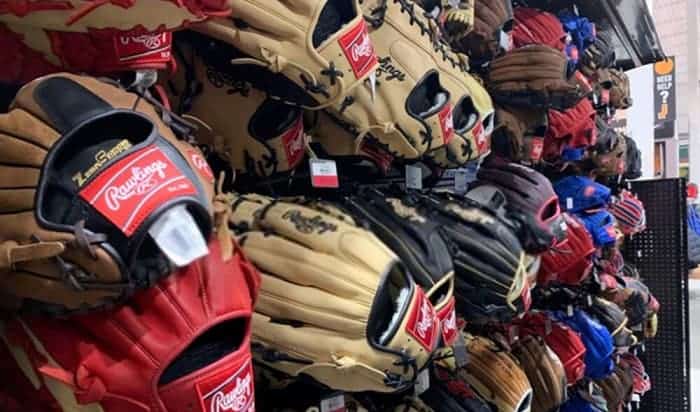MLB uses chalk lines and paint likes for calling strikes and balls. You would recognize a baseball field from any other sports field because of the distinct markings on the ground.
These lines must be as clear and accurate as possible to ensure that players see where they are supposed to move. Similarly, game officials can impose fair decisions when delineating player positions with the field lines.
With some guiding tools and a bit of practice, lining a baseball field will get easier! And here is your step-by-step guide on how to line a baseball field.
Contents
Ways to Line a Baseball Field
The proper way of putting baseball field markings involves appropriate tools. Aside from having crisp and straight lines, these tools will help make the job easier for you!
Drawing a line in baseball can be done in two ways. You can choose between these two tools:
1. Using a line chalker
First is the line chalker. This is a baseball chalk line machine that you fill with marking chalk. Then, it has a wheel mechanism that paints chalk on its path.
All you have to do is set the width of the line you are drawing and draw the baseball field diagram on the ground.
2. Using a handheld chalker
The line chalker has an alternative, which is the handheld chalker. Instead of working on wheels, the alternative involves a bucket-like contraption with a hole below.
Similar to the line chalker, you need to fill the bucket with the appropriate chalk material and draw on the lines with the hole on the bottom.
This way might be trickier as it involves a bit more manual dexterity and accuracy.
You wil need:
- Line chalker or a handheld chalker. You can use whichever is available.
- Marking chalk for baseball fields. These come in bags containing powdered chalk. It would be best to purchase your chalk from local sports stores or online and store it dry to avoid clumping.
- Baseball diamond templates to make the field lines. You can use a batter’s box template or stakes and strings.
- Shovel for removing old chalk lines (optional)
What to do:
1. Scrape off chalk on the ground from previous games
Newly lined baseball fields sometimes do not need new chalking. If the chalk line baseball field is still visible and crisp, then you can save yourself some time and proceed with the game.
Otherwise, if the striping patterns have faded, start by scraping off the old chalk line on the ground. Get your shovel and do a back-and-forth motion on the chalk to blend it into the dirt.
2. Prepare your chalker.
Choose between a line chalker or a handheld option. You can use whichever is available to you.
Begin by filling them with an appropriate amount of lining chalk and set the thickness to the appropriate measurements.
A line chalker can be set to 1” to 5” thickness. The handles or knobs usually indicate the width to be drawn.
Before using the chalker on actual field lines, you can test it out first on a piece of flat cardboard to ensure that it can give you crisp lines.
3. Begin by chalking the batter’s box
You can begin the line batter’s box. This is carried out with a U-shaped template that you can stamp on the ground.
For adult baseball, the batter’s box measures 4 feet by 6 feet while youth baseball is 3 by 6 feet.
All you need to do is make an imprint on the ground using the box template. Place the template on the ground and step all over the template so that it leaves a negative imprint on the dirt.
Then, with your prepared chalker, follow the imprint on the ground to complete the batter’s box.
4. Prepare a guide for the baseball field lines
It is best to use stakes and strings for this step. Tightly attach the string to a stake and set it on the home plate up to the first base. The string must measure around 90 feet.
Then, make a guide with the same string-and-stake method from the home plate to the third base. This would represent the third baseline.
5. Use your chalker to apply chalk on the lines created
Follow the straight paths made with the guide from the previous step. Use your chalker to stripe a baseball field based on the guides.
Make sure to follow the guide strings on one side only. Do not pour the chalk over the strings as this will interfere with the solid lines that you will draw.
6. Proceed to draw the foul lines
Repeat steps 4 and 5 to create the baseball field foul lines. These lines should extend from the batter’s box up to the left and right fields.
Frequently Asked Questions
Tips for making chalking easier
Even if you are preparing for practice games or an amateur game, you can make a professional-looking line for baseball fields! Make sure to look into these tips:
- Make sure that you are working on dry surfaces. The chalk will clump when placed on wet surfaces. So, prevent lining a baseball field after it rains.
- Pull the strings taut. The tighter they are, the straighter your field lines are going to be.
- Have a baseball field layout template with you. It can be a printed image of the lines that you need to follow. This ensures that you will have the correct measurements and you will not miss out on any important markings!
- Maintain the lines you created by using a garden rake. Rake along the length of the lines to even out the ground and smoothen the base.
Where do the lines go on a baseball field?
Lines are drawn on the ground of a baseball field. These are white lines that are visible to the players and the game officials.
However, be aware that there are also lines that are not marked on the field. These are the baselines. Baselines are the line of field, meaning, they represent a certain role in the game. These have a length of 90 feet and runners can be called out if they run past this limit.
Baseball foul lines and their thickness
A baseball foul line delineates the area where a ball is fair or foul. The width of these lines is 4 inches. And, their length spans between 300 to 350 feet.
Conclusion
No game can commence without a well-prepped field! The baseball field has its iconic markings on the ground that shows limits on where players can run or keep bases.
This article showed you simple instructions on how to line a baseball field. All you need to do is get your line chalker, template, and strings and stakes as your guide!
Of course, it would be useful to have a baseball field template before you start working so that you know how to properly draw the lines.
Begin with lining the batter’s box, field lines, and foul lines. Make sure to work on dry surfaces and keep your chalk in good condition!

A powerful swing and the ball is flying across the field, just one hit, and we might never forget the thrill it brings. I do not know about you, but I never do. Every baseball game is the chance to compete with others and cooperate with your teammate. It is among my biggest passions.
















